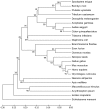Elongation factor 1β' gene from Spodoptera exigua: characterization and function identification through RNA interference
- PMID: 22942694
- PMCID: PMC3430225
- DOI: 10.3390/ijms13078126
Elongation factor 1β' gene from Spodoptera exigua: characterization and function identification through RNA interference
Abstract
Elongation factor (EF) is a key regulation factor for translation in many organisms, including plants, bacteria, fungi, animals and insects. To investigate the nature and function of elongation factor 1β' from Spodoptera exigua (SeEF-1β'), its cDNA was cloned. This contained an open reading frame of 672 nucleotides encoding a protein of 223 amino acids with a predicted molecular weight of 24.04 kDa and pI of 4.53. Northern blotting revealed that SeEF-1β' mRNA is expressed in brain, epidermis, fat body, midgut, Malpighian tubules, ovary and tracheae. RT-PCR revealed that SeEF-1β' mRNA is expressed at different levels in fat body and whole body during different developmental stages. In RNAi experiments, the survival rate of insects injected with SeEF-1β' dsRNA was 58.7% at 36 h after injection, which was significantly lower than three control groups. Other elongation factors and transcription factors were also influenced when EF-1β' was suppressed. The results demonstrate that SeEF-1β' is a key gene in transcription in S. exigua.
Keywords: RNAi; Spodoptera exigua; cloning; elongation factor; expression pattern.
Figures








Similar articles
-
Two storage hexamerins from the beet armyworm Spodoptera exigua: cloning, characterization and the effect of gene silencing on survival.BMC Mol Biol. 2010 Aug 31;11:65. doi: 10.1186/1471-2199-11-65. BMC Mol Biol. 2010. PMID: 20807423 Free PMC article.
-
Characterization of a trehalose-6-phosphate synthase gene from Spodoptera exigua and its function identification through RNA interference.J Insect Physiol. 2010 Jul;56(7):813-21. doi: 10.1016/j.jinsphys.2010.02.009. Epub 2010 Mar 7. J Insect Physiol. 2010. PMID: 20193689
-
Sequencing and characterization of glycogen synthase and glycogen phosphorylase genes from Spodoptera exigua and analysis of their function in starvation and excessive sugar intake.Arch Insect Biochem Physiol. 2012 Jun;80(1):42-62. doi: 10.1002/arch.21027. Epub 2012 Apr 30. Arch Insect Biochem Physiol. 2012. PMID: 22550018
-
Molecular characterization, expression analysis and RNAi knock-down of elongation factor 1α and 1γ from Nilaparvata lugens and its yeast-like symbiont.Bull Entomol Res. 2017 Jun;107(3):303-312. doi: 10.1017/S0007485316000882. Epub 2016 Nov 4. Bull Entomol Res. 2017. PMID: 27809951
-
Optimization of recombinant bacteria expressing dsRNA to enhance insecticidal activity against a lepidopteran insect, Spodoptera exigua.PLoS One. 2017 Aug 11;12(8):e0183054. doi: 10.1371/journal.pone.0183054. eCollection 2017. PLoS One. 2017. PMID: 28800614 Free PMC article.
Cited by
-
Discovery of midgut genes for the RNA interference control of corn rootworm.Sci Rep. 2016 Jul 28;6:30542. doi: 10.1038/srep30542. Sci Rep. 2016. PMID: 27464714 Free PMC article.
References
-
- Riis B., Rattan S.I.S., Clark B.F.C., Merrick W.C. Eukaryotic protein elongation factors. Trends Biochem. Sci. 1990;15:420–424. - PubMed
-
- Margutti P., Ortona E., Vaccari S., Barca S., Riganò R., Teggi A., Muhschlegel F., Frosch M., Siracusano A. Cloning and expression of a cDNA encoding an elongation factor 1β/δ protein from Echinococcus granulosus with immunogenic activity. Parasite Immunol. 1999;21:485–492. - PubMed
-
- Fujita T., Piuz I., Schlegel W. The transcription elongation factors NELF, DSIF and P-TEFb control constitutive transcription in a gene-specific manner. FEBS Lett. 2009;583:2893–2898. - PubMed
Publication types
MeSH terms
Substances
LinkOut - more resources
Full Text Sources
Research Materials
Miscellaneous

